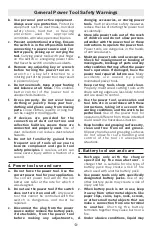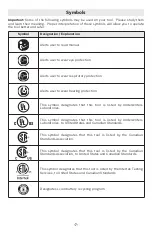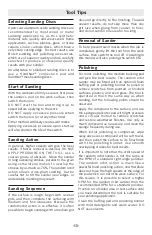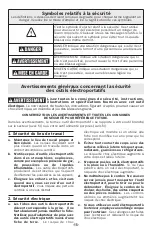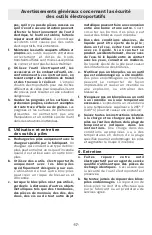
-4-
Safety Rules for Random Orbital Sanders
a. Use clamps or another practical way to
secure and support the workpiece to a
stable platform.
Holding the work by your
hand or against the body leaves it unstable
and may lead to loss of control.
b. R e m o v e b a t t e r y b e f o r e c h a n g i n g
accessories.
Accidental start-ups may
o c c u r i f b a t t e r y i s i n s t a l l e d w h i l e
changing an accessory.
c. If your tool is equipped with a dust bag,
e m p t y
i t
f r e q u e n t l y
a n d
a f t e r
completion of sanding.
Be extremely
careful of dust disposal, materials in fine
particle form may be explosive. Do not
throw sanding dust on an open fire.
Spontaneous combustion may, in time,
result from mixture of oil or water with
dust particles.
d. Always wear eye protection and a dust
mask for dusty applications and when
sanding overhead.
Sanding particles can
be absorbed by your eyes and inhaled
e a s i l y
a n d
m a y
c a u s e
h e a l t h
complications.
e. D o n o t w e t s a n d w i t h t h i s s a n d e r .
Liquids entering the motor housing is an
electrical shock hazard.
f. Do not use PSA pad on random orbit
s a n d e r s
w h o s e
s p e e d
e x c e e d s
12,000/min.
Exceeding the maximum
operating speed of pad may cause pad to
rupture or fly apart during use striking
user or bystanders.
g. D o n o t u s e s a n d p a p e r i n t e n d e d f o r
larger sanding pads.
Larger sandpaper
w i l l e x t e n d b e y o n d t h e s a n d i n g p a d
causing snagging, tearing of the paper or
kick-back. Extra paper extending beyond
the sanding pad can also cause serious
lacerations.
h. C l a m p o r s e c u r e w o r k p i e c e w h e n
s a n d i n g .
C l a m p i n g t h e w o r k p i e c e
p r e v e n t s i t f r o m b e i n g e j e c t e d f r o m
under the sander and leaves both hands
to control the tool.
General Power Tool Safety Warnings
be ejected from the battery, avoid
contact. If contact accidentally occurs,
flush with water. If liquid contacts
eyes, additionally seek medical help.
Liquid ejected from the battery may
cause irritation or burns.
e.
Do not use a battery pack or tool that
is damaged or modified.
Damaged or
m o d i f i e d
b a t t e r i e s
m a y
e x h i b i t
unpredictable behavior resulting in fire,
explosion or risk of injury.
f.
Do not expose a battery pack or tool to
fi r e
o r
e x c e s s i v e
t e m p e r a t u r e .
Exposure to fire or temperature above
265 °F may cause explosion.
g.
Follow all charging instructions and do
not charge the battery pack or tool
o u t s i d e t h e t e m p e r a t u r e r a n g e
specified in the instructions.
Charging
improperly or at temperatures outside
the specified range may damage the
battery and increase the risk of fire.
6. Service
a.
Have your power tool serviced by a
qualified r e p a i r p e r s o n u s i n g o n l y
identical replacement parts.
This will
ensure that the safety of the power tool
is maintained.
b.
Never service damaged battery packs.
Service of battery packs should only be
p e r f o r m e d b y t h e m a n u f a c t u r e r o r
authorized service providers.



